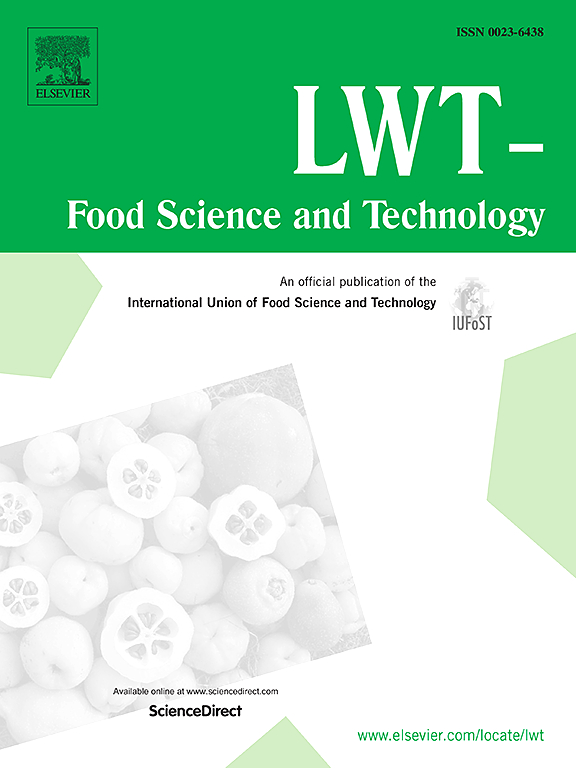应用富氢水通过调节 ROS 和能量代谢保持红塔果实的品质
IF 6.6
1区 农林科学
Q1 FOOD SCIENCE & TECHNOLOGY
引用次数: 0
摘要
富氢水(HRW)处理已被证明可以延长水果和蔬菜的保质期。本研究旨在探究富氢水对改善红塔果质量的影响及其潜在的调节机制。结果表明,使用 70% 浓度的 HRW 可以降低腐烂率和重量损失率,减缓呼吸速率,延缓可滴定酸度和总可溶性固形物的下降。此外,HRW 处理缓解了超氧阴离子生成和过氧化氢水平的增加,同时提高了抗氧化酶活性和基因表达,包括过氧化物酶、超氧化物歧化酶、谷胱甘肽过氧化物酶、过氧化氢酶、抗坏血酸过氧化物酶、单脱氢抗坏血酸还原酶和谷胱甘肽还原酶。抗坏血酸和谷胱甘肽等非酶抗氧化化合物也有所增加。此外,RT-qPCR分析表明,HRW处理上调了HcMYB6,下调了HcR2R3MYB。双荧光素酶报告实验表明,HcMYB6 激活了 HcSOD 和 HcCAT 的表达,而 HcR2R3MYB 则抑制了它们的表达。这些发现表明,HcMYB6 和 HcR2R3MYB 可能参与了活性氧代谢,HRW 处理会诱导 HcMYB6,抑制 HcR2R3MYB。此外,HRW 处理导致三磷酸腺苷和二磷酸腺苷含量增加,单磷酸腺苷含量减少,Ca2⁺-ATPase、琥珀酸氢酶、H⁺-ATPase 和细胞色素 C 的基因表达和活性升高。本文章由计算机程序翻译,如有差异,请以英文原文为准。
Application of hydrogen-rich water maintains red pitaya fruit quality through regulation of ROS and energy metabolism
Hydrogen-rich water (HRW) treatment has been shown to enhance the shelf life of fruit and vegetables. This study aimed to investigate the effects of HRW on improving the quality of red pitaya and its underlying regulatory mechanisms. The results revealed that applying HRW at a 70% concentration reduced decay and weight loss rates, slowed the respiratory rate, and delayed the decline in titratable acidity and total soluble solids. Additionally, HRW treatment mitigated the increase in superoxide anion production and hydrogen peroxide levels, while enhancing antioxidant enzyme activities and gene expression, including those of peroxidase, superoxide dismutase, glutathione peroxidase, catalase, ascorbate peroxidase, monodehydroascorbate reductase, and glutathione reductase. Non-enzymatic antioxidant compounds such as ascorbate and glutathione also increased. Moreover, RT-qPCR analysis showed that HRW treatment upregulated HcMYB6 and downregulated HcR2R3MYB. Dual-luciferase reporter assays indicated that HcMYB6 activated the expression of HcSOD and HcCAT, whereas HcR2R3MYB repressed their expression. These findings suggest that HcMYB6 and HcR2R3MYB may be involved in reactive oxygen species metabolism, with HcMYB6 being induced and HcR2R3MYB inhibited by HRW treatment. Furthermore, HRW treatment led to increased adenosine triphosphate and adenosine diphosphate levels, a decrease in adenosine monophosphate content, and elevated gene expression and activity of Ca2⁺-ATPase, succinate hydrogenase, H⁺-ATPase, and cytochrome C. Collectively, these results demonstrate that HRW treatment effectively reduces oxidative damage and improves energy status, thereby preserving the quality of red pitaya fruit.
求助全文
通过发布文献求助,成功后即可免费获取论文全文。
去求助
来源期刊

LWT - Food Science and Technology
工程技术-食品科技
CiteScore
11.80
自引率
6.70%
发文量
1724
审稿时长
65 days
期刊介绍:
LWT - Food Science and Technology is an international journal that publishes innovative papers in the fields of food chemistry, biochemistry, microbiology, technology and nutrition. The work described should be innovative either in the approach or in the methods used. The significance of the results either for the science community or for the food industry must also be specified. Contributions written in English are welcomed in the form of review articles, short reviews, research papers, and research notes. Papers featuring animal trials and cell cultures are outside the scope of the journal and will not be considered for publication.
 求助内容:
求助内容: 应助结果提醒方式:
应助结果提醒方式:


